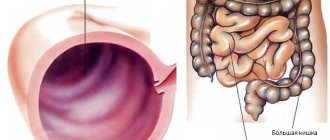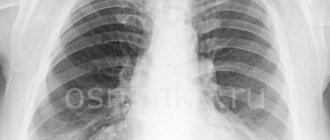Intrauterine pneumonia is an acute inflammation of the pulmonary parenchyma of infectious origin, diagnosed on the basis of typical radiographic and clinical symptoms in the first 72 hours of a baby’s life. In the structure of infant mortality from infectious pathologies, neonatal pneumonia consistently ranks second after sepsis, which is due to late verification (confirmation of diagnosis) and the lack of timely treatment aimed at eliminating the cause of the disease. The traditional treatment regimen for pneumonia in a newborn child includes intensive antibacterial treatment taking into account the identified pathogen, artificial ventilation (for health reasons) and restoration of the water and electrolyte balance of the baby’s body.
Features of the bronchi and lungs in the newborn and fetus
The fetal lungs do not contain air, but it begins to carry out pulmonary movements already at the 23rd week of pregnancy. Before this period, due to the functional and anatomical immaturity of the lungs, gas exchange does not occur in them. At the time of birth, the baby's lungs are filled with amniotic fluid, which, with the first breath, is absorbed into the space between the alveoli and blood. In premature infants, the realization of the first breath is difficult, since the immaturity of the respiratory system is accompanied by metabolic disorders and an incompletely formed heart and blood vessels.
Reasons for the tendency of newborn children to pneumonia:
- immaturity of the nervous system and pulmonary components; poor functioning of the ciliated epithelium of the bronchi;
- narrowness of the airways, complicating the process of air passage;
- decreased cough reflex;
- poor development of the intercostal muscles, which leads to a decrease in the excursion (difference in circumference between exhalation and inhalation) of the chest.
Obstetric risk factors for congenital pneumonia: prolonged fetal hypoxia, resuscitation measures during labor, infectious diseases of the woman in labor, premature rupture of amniotic fluid, long anhydrous period.
Perinatal risk factors: asphyxia at birth, low weight, morphological and functional immaturity of the infant due to prematurity.
Pathogenesis (how the disease develops)
In the pathogenesis of intrauterine pneumonia, the following are of great importance:
- infectious and inflammatory diseases of the reproductive and urinary systems of a woman in labor
- state of the surfactant system and bronchopulmonary apparatus
- gestational maturity of the fetus
- asphyxia during childbirth
- suffered intrauterine hypoxia
- malformations of the bronchial tree
- aspiration of amniotic fluid, meconium, etc.
The pathogen enters the baby's body hematogenously in the last weeks or days of pregnancy. The lungs can also become infected when amniotic fluid enters them. Another way is aspiration of the infected contents of the birth canal. The development of the infectious process is facilitated by SDR, prematurity, fetal hypoxia, and impaired cardiopulmonary adaptation. In all cases, bilateral lung damage is recorded.
Due to the reasons described above, after birth the following develop:
- deterioration of surfactant synthesis
- hypoxemia
- hypercapnia
- hypoxia
- mixed acidosis
As a result of the conditions described above, parenchymal pulmonary edema, atelectasis, and increased pressure in the lungs appear. As microcirculation becomes increasingly disrupted, it causes multiple organ failure, which first affects the lungs and heart. In CAP, which is caused by group B streptococci, respiratory disorders and hyaline membrane disease are combined.
Often, in the first days after birth, an inflammatory reaction develops in the interstitial tissue of the lungs, and multiple small atelectasis are formed.
Etiology and pathogenesis
The etiological spectrum of pneumonia in newborns in 70% of cases is interconnected with the nature of infection:
- transplacentally . Pneumonia in newborns infected in utero through the placenta manifests itself after the introduction of rubella virus, chickenpox, herpes simplex, CMV, tuberculosis microbacteria or pallid spirochete;
- perinatal _ Intrauterine pneumonia, which develops in the fetus 2-3 weeks before birth, is caused by chlamydia, mycoplasmas, anaerobes, Haemophilus influenzae, intestinal bacteria or herpes simplex virus;
- postnatally . Pneumonia in newborns during the postpartum period occurs due to infection with respiratory viruses, Staphylococcus aureus, candida, and intestinal bacteria. Influenza and parainfluenza viruses can only provoke bronchitis or an infection of the respiratory tract (upper), however, against the background of these diseases, in 40-45% of cases, unilateral pneumonia or a more severe pathology – bilateral pneumonia “starts”.
Pneumonia in premature infants is classified as a special group. Intrauterine pneumonia in such newborns is caused by class B streptococci. Early infection in them is characterized by an extremely severe course, leading to death in 40% of cases, 3 times higher than the same indicators in premature infants in the absence of infection.
Covid threatens pregnant women and babies. The doctor gave clear recommendations
Women are hearing the diagnosis of “intrauterine pneumonia” more and more often. Premature birth, the baby is born and cannot take its first breath. Next comes resuscitation and the doctors’ struggle for life. Coronavirus contracted in the first and second trimesters can lead to such dire consequences. How to plan a pregnancy in this situation? Presenter Maria Ivatkina talked about this in the First Russian studio with a doctor of the highest category, obstetrician-gynecologist Alla Pashkova.
Maria Ivatkina: Have you encountered cases of coronavirus in pregnant women in your medical practice?
Alla Pashkova: Of course, we met. Although I do not work in a maternity hospital, which is focused on delivering births to women in labor with coronavirus, nevertheless, among my pregnant women there were patients with coronavirus infection.
– How does this complicate pregnancy? How does this affect the health of the woman and the unborn child?
– Mostly in pregnant women the disease is quite mild. Most often, this is either asymptomatic, mild, or moderate course of the disease, which does not affect the health of children. Women carry their pregnancies to term and give birth to healthy children. The risk of preterm birth, if we talk about healthy women, is about 6-7%.
Thrombosis, premature birth - what is the danger of Covid for pregnant women?
But among pregnant women with coronavirus infection, one in five may have either late miscarriages or premature births with the risk of having low birth weight babies with breathing problems, because most of them have respiratory distress syndrome. Well, and, accordingly, then, in the future, there are risks of damage to the organs of vision, hearing, cerebral palsy, and so on.
For a mother, Covid in case of a severe course of the disease is dangerous due to bleeding and thrombosis due to the fact that against the background of coronavirus infection, hypercoagulation is often observed, that is, an increase in blood clotting.
And if a pregnant woman has obesity, cardiovascular disease or thrombophilia, then, accordingly, the risk of thrombosis is even higher. In addition, there is a threat of antenatal fetal death or premature abruption of a normally located placenta.
Therefore, such pregnant women are at risk both for thrombosis in themselves and for thrombosis in the vessels of the placental bed. That is, this is both antenatal fetal death and premature abruption of a normally located placenta.
– What preventive measures can be taken in this case?
– It all depends on the course of the disease – mild, moderate or severe. In moderate and severe cases, the woman will be hospitalized and specialists will take care of her.
If the disease is mild or even asymptomatic, then it is better to stay at home. If the temperature rises above 38–38.5, then antipyretic drugs, plenty of fluids and, naturally, vitamins, possibly D3, are prescribed. Good nutrition and adherence to the regime are necessary.
In general, you need to follow the usual preventive measures: avoid close quarters, contact with large numbers of people, wash your hands more often, treat them with sanitizers, wear a mask, changing it every three hours.
– Do I understand correctly that the treatment of pregnant women for coronavirus is somewhat different?
– There are no serious differences; in general, the treatment follows the same scenario. Of course, it all depends on the form in which the disease occurs. In severe cases, if mechanical ventilation is required, the question of emergency delivery may arise, because pregnancy itself is a big burden on the body. And it turns out that in a stressful situation, when the body’s forces are aimed at survival, pregnancy is a kind of aggravating moment.
– Which takes away strength from the body.
- Yes. This includes an additional intake of nutrients, and the need to ensure placental blood flow, and to grow a new organism inside oneself.
Plus, this is a special “agreement” of the immune system. Because a fetus is, one might say, a genetically alien organism. And here an adequate immune response is needed so that it is not rejected, so that it lives and develops. And when a coronavirus infection interferes with this process, everything in the body is disrupted.
How is Covid treated during pregnancy?
– It turns out that pregnant women are a “risk group” for coronavirus?
- Undoubtedly. And studies that have been conducted have shown that the likelihood of infection in pregnant women is quite high. However, their severe form occurs in no more than 5% of cases, that is, infrequently.
– I didn’t just ask the question about treating Covid during pregnancy. Many women during this period are often afraid to take any medications. And here the question arises: what is worse, an infection that develops inside the body and can harm the unborn child, or medications that, hypothetically, can also harm both mother and child.
– This is a completely wrong approach. Unfortunately, for some reason in our post-Soviet space there is an opinion that if you are pregnant, if it is a newborn child, then the medicine should absolutely not be taken. That it is harmful, that you need to be treated with plantain, and so on.
But evidence-based medicine is evidence-based because it is based on protocols for the management of certain diseases, and they do not arise out of the blue, but as a result of serious independent studies in different countries with control groups.
For example, in the USA there is a gradation of medications. For example, group A medications are absolutely safe during pregnancy. Group B drugs must be taken with caution, and so on.
Although we encountered coronavirus not so long ago, some experience in treating the disease during pregnancy has already been accumulated, and the necessary drugs to reduce the risk of complications have been approved.
Mom is sick, how will this affect the child?
– And if a woman suffers a coronavirus infection easily and, perhaps, even asymptomatically, does this subsequently affect the health of the child? Is it possible for him to develop intrauterine pneumonia?
– According to current studies, the total passage of the virus from mother to fetus through the placental barrier is excluded. However, cases where premature babies were born with intrauterine pneumonia with confirmation of the diagnosis of coronavirus infection have already been described in the specialized literature. But these are isolated cases when children were born from somatically burdened mothers - with obesity, diabetes, arterial hypertension, and so on.
So, for the most part, coronavirus is not transmitted to the child during pregnancy. It’s another matter if the infection occurred after childbirth, as a result of close contact.
You shouldn’t assume that if a mother gets sick with Covid, then the child will definitely have intrauterine pneumonia. Of course not. This happens in isolated cases. As for intrauterine pneumonia itself, we are faced with it even without an epidemic of coronavirus infection - it can be caused not only by viruses, but also by bacteria.
– Tell me, does the form of the disease depend solely on some other diseases that the woman has? Or could it be a perfectly healthy young pregnant woman who fell ill with coronavirus, and, unfortunately, her case turned out to be fatal?
– One of the latest American studies showed that the probability of death in pregnant women infected with coronavirus is about 1 in 709 cases. Moreover, the probability of death in a healthy pregnant woman is 1 in 20 thousand. That is, the difference is obvious.
As for the risk group, as I have already said, it includes pregnant women with obesity, arterial hypertension, diseases of the cardiovascular system, severe liver and kidney diseases, as well as previous cancer.
Unfortunately, we have a large number of women with lipid metabolism disorders during pregnancy, with gestational diabetes mellitus. And all because we lack a nutritional culture and there is no proper management of such pregnant women. Often no one pays attention to properly conducting screening of the first trimester with an assessment of the risk of preeclampsia and fetal growth restriction syndrome.
– We learned about the first case of Covid in a pregnant woman in March 2021, that is, almost a year and a half has passed. What conclusions have we drawn during this time, what mistakes have we corrected and what have we learned to do?
– At present, a scheme has already been clearly worked out on how to correctly diagnose and prescribe treatment if a pregnant woman becomes infected with a coronavirus infection. Everywhere in our country there are hospitals that are focused on providing assistance to pregnant women with coronavirus infection. Naturally, experience has been accumulated in terms of treatment regimens and approaches to treating such patients.
When should pregnant women get vaccinated?
– Many people are interested in the issue of vaccination of pregnant women.
– As a doctor, I have a positive attitude towards vaccination. And think for yourself. The vaccines currently in use, including those against coronavirus, are non-living. It has long been known that only live vaccines are dangerous for pregnant women. Well, for example, the vaccine against chickenpox, measles, rubella, and the human papillomavirus is recombinant.
A dead vaccine is an inactivated virus. This is just Sputnik-V. This vaccine is an inactivated adenovirus into which only a small piece of coronavirus DNA is embedded, which is also inactivated and non-living.
When such a vaccine is administered, antibodies are produced against the adenovirus, which is the conductor and, accordingly, the DNA of the coronavirus. That is, when the body encounters a live coronavirus, its cells are not able to cling to human cells and destroy them.
Now I’ll touch on the myths associated with the vaccine. The first is that the vaccine will lead to infertility. Let's think logically. What causes infertility? Or the eggs age, the follicles are destroyed. This happens if the ovaries have been operated on multiple times.
Another reason is age-related aging. The supply of eggs at 45 years old is different from the supply at 20 years old. But not a single virus is capable of infecting follicles and destroying eggs. Only hyperthermia is dangerous for the destruction of eggs, as well as for sperm.
If a person has a high temperature for a long time, then cell denaturation may occur, that is, they will be destroyed.
– Another important question. If a woman is planning a pregnancy, how long before should she get vaccinated?
– The English Society for Reproductive Medicine has issued a mandatory recommendation for couples planning a pregnancy to be vaccinated. Considering that, according to statistics, pregnancy occurs in 90% of couples in the 8–9th month of planning, we do not know what will happen during this period. Obviously, the recommendation of British experts is quite correct.
As for the vaccine itself, it is, as I already said, inactivated. It is not passed into breast milk and does not penetrate the placental barrier.
If you listen to myths that something bad can happen in five to seven years, then let’s first turn on logic. The components of the vaccine remain in our body for no more than three weeks. During this time, either antibodies will be developed or not. After three weeks, the body will no longer remember this component of the vaccine. Therefore, questions about revaccination constantly arise.
– What week is it better for a pregnant woman to get vaccinated?
– According to the recommendations of the Ministry of Health, pregnant women at risk can be vaccinated with Sputnik-V at 22 weeks. Earlier than this period is not recommended, because the evidence base has not yet been collected.
But the same Pfizer abroad is allowed to be vaccinated in the early stages; it is also allowed for nursing mothers.
Clinical picture
Intrauterine pneumonia manifests itself as cyanosis, depression or excitability of the central nervous system, and failure of temperature control. Possible swelling of the wings of the nose, shallow rapid or “grunting” breathing, symptoms of respiratory failure, cough with foamy discharge, hemorrhagic signs, hemodynamic disorders, jaundice. Moist rales are heard against the background of weak breathing. All these clinical symptoms are nonspecific and can be observed in infants who are born with low birth weight, so if a woman gave birth to a premature baby and observes similar symptoms, it is necessary first of all to exclude respiratory distress syndrome in the baby.
Additional symptoms of the disease in children with intrauterine pneumonia:
- regular regurgitation, refusal to eat;
- fatigue during breastfeeding;
- fever, pronounced shortness of breath;
- increased bleeding, sclerema;
- enanthema/exanthema (rash on mucous membranes);
- symptoms of toxicosis, cardiovascular abnormalities.
The consequences of pneumonia in newborns can be extremely severe. Some infectious agents (staphylococci, Pseudomonas aeruginosa) provoke early decaying infiltrates with destructive cavities in the lungs and purulent pleurisy. The prognosis is worsened by decreased immunity and poor efficiency of bronchial cleansing due to aspiration of food or cystic fibrosis. Toxic complications (disorders of the heart muscle and central nervous system, microcirculation) depend on the severity of the pathological process and the adequacy of the treatment. After pneumonia, abscesses, pneumothorax, atelectasis, otitis media, sepsis, sinusitis, and blood clots may occur.
Consequences of congenital pneumonia
If the causative agent of pneumonia quickly causes destruction of lung tissue, then complications in the form of abscess and gangrene of the lung are possible. Microorganisms entering the child’s blood cause sepsis. Systemic complications such as hemorrhagic syndrome, hemodynamic disorders, disseminated internal coagulation syndrome, and acute cardiovascular failure may develop. Complications from the respiratory system also develop - pleurisy, atelectasis, pneumothorax. After congenital pneumonia, a child may develop heart defects, develop a chronic form of infection and intellectual impairment.
Diagnostic measures
Diagnosis is based on the results of laboratory, clinical, anamnestic and radiological data. Radiography is of priority, since the symptoms of pneumonia in newborns are nonspecific. It is very important to correctly assess the medical history, highlighting the infectious causes of the disease.
Diagnostic criteria:
Basic:
- seeding the child and the woman in labor with the same pathogenic microflora in the first 24 hours of life;
- the presence of infiltrative shadows on the radiograph;
- development of pneumonia against the background of aspiration syndrome during the first 72 hours of life.
Auxiliary:
- the presence of fluid in the pleural cavity from the first day of life;
- signs of inflammation identified during histology of the placenta;
- increased concentration of immunoglobulin M in blood serum;
- enlarged liver and spleen;
- the presence of sputum mixed with pus during tracheal intubation in the first 72 hours of the baby’s life;
- confirmed infections in the mother;
- increased bronchovascular pattern on the x-ray in combination with reduced transparency of the pulmonary field;
- negative dynamics in the blood test on days 2-3 of life;
- leukocytosis against the background of a shift to the left of the leukocyte formula on the first day of life.
The diagnosis of “congenital pneumonia” is made when at least one main diagnostic sign or three auxiliary signs are identified.
Diagnosis of congenital pneumonia
The main methods for diagnosing congenital pneumonia are laboratory and instrumental research methods. They can be taken at partner clinics.
Changes in laboratory data that may indicate congenital pneumonia are not specific. In newborns, the number of blood cells normally increases to ensure normal cellular respiration, and on the fifth day a physiological leukocyte crossover occurs. Congenital pneumonia may be supported by an increase in the number of leukocytes over time and the absence of leukocyte crossover on the fifth day of the baby’s life. This indicates the bacterial nature of pneumonia and allows us to exclude the viral etiology of pneumonia.
Since the main source of infection is the mother, doctors at the Yusupov Hospital prescribe an examination to determine the type of pneumonia causative agent in the child. To do this, a serological study of maternal blood is carried out to determine antibodies to certain infections. The level of antibodies of the immunoglobulin class G and M is determined. At the Yusupov Hospital, laboratory assistants use special reagents that make it possible to determine the level of these antibodies. If the level of immunoglobulin G is elevated, this means that the virus cannot be involved in the development of pneumonia in a child, since it only indicates an old infection. If immunoglobulins M, which are markers of an acute infectious process, are detected, there is a high probability that the fetus is also infected. Women also undergo a bacteriological examination of a vaginal smear
X-ray signs of congenital pneumonia in the initial stages of the disease are collapse (atelectasis) of the lungs and increased vascular pattern. Over time, inflammatory and infiltrative changes of a confluent nature appear. Differential diagnosis of congenital pneumonia is carried out with hyaline membrane disease and aspiration syndrome, diaphragmatic hernia, congenital malformations of the lungs, heart pathology and injuries of the central nervous system, which are accompanied by respiratory failure.
Treatment
The therapeutic regimen includes symptomatic, etiotropic and pathogenetic treatment, organization of appropriate nutrition and care.
Stages:
- antibacterial therapy . Antibiotics are prescribed immediately, taking into account previous experience with drugs of this class. Treatment usually begins with drugs that have a broad spectrum of action. At the second stage, therapy is carried out with drugs of a directed spectrum of influence. Starting medications for antibiotic therapy of early infection are a combination of Ampicillin and Cephalosporin. If a pathogen is identified, antibiotic treatment is carried out in accordance with the antibiogram data;
- immunocorrective therapy . Indicated in the presence of immunological abnormalities, human immunoglobulin is used intravenously;
- respiratory therapy . With its help, the necessary alveolar ventilation and adequate gas exchange are maintained, the risks of barotrauma are minimized, and desynchronization is eliminated;
- infusion therapy . Provides the required level of water and electrolyte balance with mandatory monitoring of postnatal maturation of the child’s renal function.
Complex treatment is implemented taking into account the individual characteristics of the baby’s health condition, which allows you to quickly stop inflammation in the respiratory tract, reduce the time of artificial ventilation, and prevent the development of life-threatening complications. A sick child must be provided with constant care: feed formula or breast milk from a tube until respiratory problems disappear completely, carefully care for the skin, create comfortable indoor conditions that prevent the baby from overheating or hypothermia. Treatment is carried out in a hospital under the supervision of doctors, rehabilitation after an illness is carried out within 12 months - during this entire period the child must be registered with a pediatrician.
The role of antiviral therapy in pneumonia
It is known that inflammation of the respiratory tract is usually a complication caused by a viral or bacterial infection. Even an experienced doctor cannot determine whether pneumonia is viral or of another nature and make a final diagnosis regarding the cause of the disease during the first examination of a small patient. To do this, it is necessary to do a number of clinical and laboratory tests, for example, conduct a sputum, blood test, and take an X-ray of the lungs. All this takes time, which, as a rule, is not much. Therefore, most often the doctor is prompted to the viral nature of pneumonia by a characteristic sound when listening to the respiratory tract. Thus, doctors can rightfully prescribe antiviral drugs. Such drugs include Viferon Suppositories. It contains interferon protein, which prevents the proliferation of viruses, as well as vitamins C and E, which are antioxidants and contribute to the better functioning of interferon in the human body. Thanks to its dosage form (rectal suppositories), Viferon, when introduced into the patient’s rectum, begins to act very quickly, without creating additional stress on the baby’s digestive system. The drug is indicated for children from the first days of life, and even for premature babies. The use of the drug VIFERON® as part of complex therapy makes it possible to reduce therapeutic doses of antibacterial and hormonal drugs, as well as reduce the toxic effects of this therapy.
Prevention:
- eliminating, if possible, all provoking and predisposing risk factors;
- thorough examination and health improvement of women planning pregnancy, relief of inflammatory foci before conception;
- monitoring the course of pregnancy and fetal development, excluding factors potentially dangerous for the intrauterine development of the child, screening studies, competent management of childbirth;
- prevention of birth injuries;
- implementation of epidemiological and sanitary measures in the maternity hospital, compliance with the incubation regime (for premature babies);
- limiting contact of a newborn with infectious patients.
Pneumonia is a dangerous disease that can subsequently lead to bronchopulmonary dysplasia, frequent respiratory and cold infections, bronchitis, and a decreased immune response. Considering the high mortality rate from pneumonia and its complications among newborns, treatment should be timely and rational - this allows to achieve a positive result of therapy and improves the prognosis of the disease.
Antiviral drugs for pneumonia
Is it necessary to use antiviral drugs for pneumonia? More often, pneumonia has a mixed etiology; in other words, several pathogens can be present in the body at once: viruses, bacteria and sometimes even fungi. That is why doctors more often prescribe complex therapy, which includes both antibacterial and antiviral drugs. Of course, as with any other disease, self-medication and self-prescription of certain drugs is unacceptable, especially when it comes to the health of a child.








